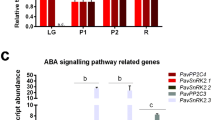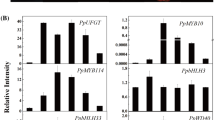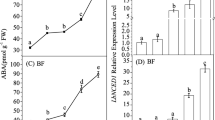Abstract
Main conclusion
Light and ABA independently regulated anthocyanin biosynthesis via activation of FaMYB10 expression. FaMYB10 accelerated anthocyanin synthesis of pelargonidin 3-glucoside and cyanidin 3-glucoside during strawberry fruit ripening.
Light is an integral factor in fruit ripening. Ripening in non-climacteric fruit is also effected by the plant hormone abscisic acid (ABA). However, how light and/or ABA regulate fruit ripening processes, such as strawberry color development remains elusive. Results of the present study showed light and ABA regulated strawberry fruit coloration via activation of FaMYB10 expression, an R2R3 MYB transcription factor. Light exposure increased FaMYB10 transcript levels, flavonoid pathway genes, and anthocyanin content. Exogenous ABA promoted FaMYB10 expression, and anthocyanin content, accompanied by increased ABA-responsive transcript levels and flavonoid pathway genes. ABA biosynthesis inhibitor treatment, and RNAi-mediated down-regulation of the ABA biosynthetic gene (9-cis epoxycarotenoid dioxygenase: FaNCED1), and ABA receptor (magnesium chelatase H subunit: FaCHLH/ABAR) showed inverse ABA effects. Furthermore, additive effects were observed in anthocyanin accumulation under combined light and ABA, indicating independent light and ABA signaling pathways. FaMYB10 down-regulation by Agrobacterium-mediated RNA interference (RNAi) in strawberry fruits showed decreased pelargonidin 3-glucoside and cyanidin 3-glucoside levels, accompanied by consistent flavonoid pathway gene expression levels. FaMYB10 over-expression showed opposite FaMYB10 RNAi phenotypes, particularly cyanidin 3-glucoside synthesis by FaMYB10, which was correlated with FaF3′H transcript levels. These data provided evidence that light and ABA promoted FaMYB10 expression, resulting in anthocyanin accumulation via acceleration of flavonoid pathway gene expression. Finally, our results suggested FaMYB10 serves a role as a signal transduction mediator from light and ABA perception to anthocyanin synthesis in strawberry fruit.







Similar content being viewed by others
Abbreviations
- ABA:
-
Abscisic acid
- CHS:
-
Chalcone synthase
- CHI:
-
Chalcone isomerase
- CHLH/ABAR:
-
Magnesium chelatase H subunit
- F3′H:
-
Flavonoid 3′-hydroxylase
- F3H:
-
Flavanone 3-hydroxylase
- DFR:
-
Dihydroflavonol-4-reductase
- ANS:
-
Anthocyanidin synthase
- FGT:
-
Flavonoid glycosyltransferase
- TF:
-
Transcription factors
- NCED:
-
9-cis epoxycarotenoid dioxygenase
References
Aharoni A, De Vos CH, Wein M, Sun Z, Greco R, Kroon A, Mol JN, O’Connell AP (2001) The strawberry FaMYB1 transcription factor suppresses anthocyanin and flavonol accumulation in transgenic tobacco. Plant J 28:319–332. doi:10.1046/j.1365-313X.2001.01154.x
Ahmad M, Lin C, Cashmore AR (1995) Mutations throughout an Arabidopsis blue-light photoreceptor impair blue-light-responsive anthocyanin accumulation and inhibition of hypocotyl elongation. Plant J 8:653–658. doi:10.1046/j.1365-313X.1995.08050653.x
Alexander L, Grierson D (2002) Ethylene biosynthesis and action in tomato: a model for climacteric fruit ripening. J Exp Bot 53:2039–2055. doi:10.1093/jxb/erf072
Almeida JR, D’Amico E, Preuss A, Carbone F, de Vos CH, Deiml B, Mourgues F, Perrotta G, Fischer TC, Bovy AG, Martens S, Rosati C (2007) Characterization of major enzymes and genes involved in flavonoid and proanthocyanidin biosynthesis during fruit development in strawberry (Fragaria xananassa). Arch Biochem Biophys 465:61–71. doi:10.1016/j.abb.2007.04.040
Anttonen MJ, Hoppula KI, Nestby R, Verheul MJ, Karjalainen RO (2006) Influence of fertilization, mulch color, early forcing, fruit order, planting date, shading, growing environment, and genotype on the contents of selected phenolics in strawberry (Fragaria × ananassa Duch.) fruits. J Agric Food Chem 54:2614–2620. doi:10.1021/jf052947w
Azuma A, Yakushiji H, Koshita Y, Kobayashi S (2012) Flavonoid biosynthesis-related genes in grape skin are differentially regulated by temperature and light conditions. Planta 236:1067–1080. doi:10.1007/s00425-012-1650-x
Baudry A, Heim MA, Dubreucq B, Caboche M, Weisshaar B, Lepiniec L (2004) TT2, TT8, and TTG1 synergistically specify the expression of BANYULS and proanthocyanidin biosynthesis in Arabidopsis thaliana. Plant J 39:366–380. doi:10.1111/j.1365-313X.2004.02138.x
Borevitz JO, Xia Y, Blount J, Dixon RA, Lamb C (2000) Activation tagging identifies a conserved MYB regulator of phenylpropanoid biosynthesis. Plant Cell 12:2383–2394. doi:10.1105/tpc.12.12.2383
Carbone F, Preuss A, De Vos RC, D’Amico E, Perrotta G, Bovy AG, Martens S, Rosati C (2009) Developmental, genetic and environmental factors affect the expression of flavonoid genes, enzymes and metabolites in strawberry fruits. Plant Cell Environ 32:1117–1131. doi:10.1111/j.1365-3040.2009.01994.x
Chai YM, Jia HF, Li CL, Dong QH, Shen YY (2011) FaPYR1 is involved in strawberry fruit ripening. J Exp Bot 62:5079–5089. doi:10.1093/jxb/err207
Chatterjee M, Sharma P, Khurana JP (2006) Cryptochrome 1 from Brassica napus is up-regulated by blue light and controls hypocotyl/stem growth and anthocyanin accumulation. Plant Physiol 141:61–74. doi:10.1104/pp.105.076323
Chernys JT, Zeevaart JAD (2007) Characterization of the 9-cis-epoxycarotenoid dioxygenase gene family and the regulation of abscisic acid biosynthesis in avocado. Plant Physiol 124:343–353. doi:10.1104/pp.124.1.343
Cominelli E, Gusmaroli G, Allegra D, Galbiati M, Wade HK, Jenkins GI, Tonelli C (2008) Expression analysis of anthocyanin regulatory genes in response to different light qualities in Arabidopsis thaliana. J Plant Physiol 165:886–894. doi:10.1016/j.jplph.2007.06.010
Daminato M, Guzzo F, Casadoro G (2013) A SHATTERPROOF-like gene controls ripening in non-climacteric strawberries, and auxin and abscisic acid antagonistically affect its expression. J Exp Bot 64:3775–3786. doi:10.1093/jxb/ert214
Davies C, Boss PK, Robinson SP (1997) Treatment of grape berries, a nonclimacteric fruit with a synthetic auxin, retards ripening and alters the expression of developmentally regulated genes. Plant Physiol 115:1155–1161. doi:10.1104/pp.115.3.1155
Deikman J (1997) Molecular mechanisms of ethylene regulation of gene transcription. Physiol Plant 100:561–566. doi:10.1111/j.1399-3054.1997.tb03061.x
Dubos C, Le Gourrierec J, Baudry A, Huep G, Lanet E, Debeaujon I, Routaboul JM, Alboresi A, Weisshaar B, Lepiniec L (2008) MYBL2 is a new regulator of flavonoid biosynthesis in Arabidopsis thaliana. Plant J 55:940–953. doi:10.1111/j.1365-313X.2008.03564.x
Dussi MC, Sugar D, Wrolstad RE (1995) Characterizing and quantifying anthocyanins in red pears and the effect of light quality on fruit color. J Am Soc Hortic Sci 120:785–789
Fait A, Hanhineva K, Beleggia R, Dai N, Rogachev I, Nikiforova VJ, Fernie AR, Aharoni A (2008) Reconfiguration of the achene and receptacle metabolic networks during strawberry fruit development. Plant Physiol 148:730–750. doi:10.1104/pp.108.120691
Finkelstein RR, Gampala SS, Rock CD (2002) Abscisic acid signaling in seeds and seedlings. Plant Cell 14:S15–S45. doi:10.1105/tpc.010441
Gapper NE, McQuinn RP, Giovannoni JJ (2013) Molecular and genetic regulation of fruit ripening. Plant Mol Biol 82:575–591. doi:10.1007/s11103-013-0050-3
Giliberto L, Perrotta G, Pallara P, Weller JL, Fraser PD, Bramley PM, Fiore A, Tavazza M, Giuliano G (2005) Manipulation of the blue light photoreceptor cryptochrome 2 in tomato affects vegetative development, flowering time, and fruit antioxidant content. Plant Physiol 137:199–208. doi:10.1104/pp.104.051987
Giovannoni JJ (2004) Genetic regulation of fruit development and ripening. Plant Cell 16:S170–S180. doi:10.1105/tpc.019158
He J, Giusti MM (2010) Anthocyanins: natural colorants with health-promoting properties. Annu Rev Food Sci Technol 1:163–187. doi:10.1146/annurev.food.080708
Hirayama T, Shinozaki K (2007) Perception and transduction of abscisic acid signals: keys to the function of the versatile plant hormone ABA. Trends Plant Sci 12:343–351. doi:10.1016/j.tplants.2007.06.013
Hoffmann T, Kalinowski G, Schwab W (2006) RNAi-induced silencing of gene expression in strawberry fruit (Fragaria × ananassa) by agroinfiltration: a rapid assay for gene function analysis. Plant J 48:818–826. doi:10.1111/j.1365-313X.2006.02913.x
Jia HJ, Araki A, Okamoto G (2005) Influence of fruit bagging on aroma volatiles and skin coloration of “Hakuho” peach (Prunus persica Batsch). Postharvest Biol Technol 35:61–68. doi:10.1016/j.postharvbio.2004.06.004
Jia HF, Chai YM, Li CL, Lu D, Luo JJ, Qin L, Shen YY (2011) Abscisic acid plays an important role in the regulation of strawberry fruit ripening. Plant Physiol 157:188–199. doi:10.1104/pp.111.177311
Jia H, Wang Y, Sun M, Li B, Han Y, Zhao Y, Li X, Ding N, Li C, Ji W, Jia W (2013a) Sucrose functions as a signal involved in the regulation of strawberry fruit development and ripening. New Phytol 198:453–465. doi:10.1111/nph.12176
Jia HF, Lu D, Sun JH, Li CL, Xing Y, Qin L, Shen YY (2013b) Type 2C protein phosphatase ABI1 is a negative regulator of strawberry fruit ripening. J Exp Bot 64:1677–1687. doi:10.1093/jxb/ert028
Jiang Y, Joyce DC (2003) ABA effects on ethylene production, PAL activity, anthocyanin and phenolic contents of strawberry fruit. Plant Growth Regul 39:171–174. doi:10.1023/A:1022539901044
Jin H, Cominelli E, Bailey P, Parr A, Mehrtens F, Jones J, Tonelli C, Weisshaar B, Martin C (2000) Transcriptional repression by AtMYB4 controls production of UV-protecting sunscreens in Arabidopsis. EMBO J 19:6150–6161. doi:10.1093/emboj/19.22.6150
Josuttis M, Dietrich H, Treutter D, Will F, Linnemannstöns L, Krüger E (2010) Solar UVB response of bioactives in strawberry (Fragaria × ananassa Duch. L.): a comparison of protected and open-field cultivation. J Agric Food Chem 58:12692–12702. doi:10.1021/jf102937e
Kadomura-Ishikawa Y, Miyawaki K, Noji S, Takahashi A (2013) Phototropin 2 is involved in blue light-induced anthocyanin accumulation in Fragaria × ananassa fruits. J Plant Res 126:847–857. doi:10.1007/s10265-013-0582-2
Kami C, Lorrain S, Hornitschek P, Fankhauser C (2010) Light-regulated plant growth and development. Curr Top Dev Biol 91:29–66. doi:10.1016/S0070-2153(10)91002-8
Kano Y, Asahira T (1981) Roles of cytokinin and abscisic acid in the maturing of strawberry fruits. J Jpn Soc Hortic Sci 50:31–36
Karppinen K, Hirvelä E, Nevala T, Sipari N, Suokas M, Jaakola L (2013) Changes in the abscisic acid levels and related gene expression during fruit development and ripening in bilberry (Vaccinium myrtillus L.). Phytochemistry 95:127–134. doi:10.1016/j.phytochem.2013.06.023
Kataoka I, Beppu K (2004) UV irradiance increases development of red skin color and anthocyanins in “Hakuho” peach. HortScience 39:1234–1237
Kim SH, Lee JR, Hong ST, Yoo YK, An G, Kim SR (2003) Molecular cloning and analysis of anthocyanin biosynthesis genes preferentially expressed in apple skin. Plant Sci 165:403–413. doi:10.1016/S0168-9452(03)00201-2
Klee HJ, Giovannoni JJ (2011) Genetics and control of tomato fruit ripening and quality attributes. Annu Rev Genet 45:41–59. doi:10.1146/annurev-genet-110410-132507
Kobashi K, Gemma H, Iwahori S (1999) Sugar accumulation in peach fruit as affected by abscisic acid (ABA) treatment in relation to some sugar metabolizing enzymes. J Jpn Soc Hortic Sci 68:465–470
Koes R, Verweij W, Quattrocchio F (2005) Flavonoids: a colorful model for the regulation and evolution of biochemical pathways. Trends Plant Sci 10:236–242. doi:10.1016/j.tplants.2005.03.002
Kortstee AJ, Khan SA, Helderman C, Trindade LM, Wu Y, Visser RG, Brendolise C, Allan A, Schouten HJ, Jacobsen E (2011) Anthocyanin production as a potential visual selection marker during plant transformation. Transgenic Res 20:1253–1264. doi:10.1007/s11248-011-9490-1
Li C, Jia H, Chai Y, Shen Y (2011) Abscisic acid perception and signaling transduction in strawberry: a model for non-climacteric fruit ripening. Plant Signal Behav 6:1950–1953. doi:10.4161/psb.6.12.18024
Li YY, Mao K, Zhao C, Zhao XY, Zhang RF, Zhang HL, Shu HR, Hao YJ (2013) Molecular cloning and functional analysis of a blue light receptor gene MdCRY2 from apple (Malus domestica). Plant Cell Rep 32:555–566. doi:10.1007/s00299-013-1387-4
Lin-Wang K, Bolitho K, Grafton K, Kortstee A, Karunairetnam S, McGhie TK, Espley RV, Hellens RP, Allan AC (2010) An R2R3 MYB transcription factor associated with regulation of the anthocyanin biosynthetic pathway in Rosaceae. BMC Plant Biol 21(10):50. doi:10.1186/1471-2229-10-50
Lopes-da-Silva F, Escribano-Bailòn MT, Pérez Alonso JJ, Rivas-Gonzalo JC, Santos-Buelga C (2007) Anthocyanin pigments in strawberry. LWT Food Sci Technol 40:374–382. doi:10.1016/j.lwt.2005.09.018
Matsui K, Umemura Y, Ohme-Takagi M (2008) AtMYBL2, a protein with a single MYB domain, acts as a negative regulator of anthocyanin biosynthesis in Arabidopsis. Plant J 55:954–967. doi:10.1111/j.1365-313X.2008.03565.x
Medina-Puche L, Cumplido-Laso G, Amil-Ruiz F, Hoffmann T, Ring L, Rodríguez-Franco A, Caballero JL, Schwab W, Muñoz-Blanco J, Blanco-Portales R (2014) MYB10 plays a major role in the regulation of flavonoid/phenylpropanoid metabolism during ripening of Fragaria × ananassa fruits. J Exp Bot 65:401–417. doi:10.1093/jxb/ert377
Miyawaki K, Fukuoka S, Kadomura Y, Hamaoka H, Mito T, Ohuchi H, Schwab W, Noji S (2012) Establishment of a novel system to elucidate the mechanisms underlying light-induced ripening of strawberry fruit with an Agrobacterium-mediated RNAi technique. Plant Biotechnol 29:271–277. doi:10.5511/plantbiotechnology.12.0406a
Nakashima K, Yamaguchi-Shinozaki K (2013) ABA signaling in stress-response and seed development. Plant Cell Rep 32:959–970. doi:10.1007/s00299-013-1418-1
Pan QH, Li MJ, Peng CC, Zhang N, Zou X, Zou KQ, Wang XL, Yu XC, Wang XF, Zhang DP (2005) Abscisic acid activates acid invertases in developing grape berry. Physiol Plant 125:157–170. doi:10.1111/j.1399-3054.2005.00552.x
Qin X, Zeevaart JA (1999) The 9-cis-epoxycarotenoid cleavage reaction is the key regulatory step of abscisic acid biosynthesis in water-stressed bean. Proc Natl Acad Sci USA 96:15354–15361. doi:10.1016/j.jplph.2009.01.013
Rodrigo MJ, Marcos JF, Alférez F, Mallent MD, Zacarías L (2003) Characterization of Pinalate, a novel Citrus sinensis mutant with a fruit specific alteration that results in yellow pigmentation and decreased ABA content. J Exp Bot 54:727–738. doi:10.1093/jxb/erg083
Rodrigo MJ, Alquezar B, Zacarı´as L (2006) Cloning and characterization of two 9-cis-epoxycarotenoid dioxygenase genes, differentially regulated during fruit maturation and under stress conditions, from orange (Citrus sinensis L. Osbeck). J Exp Bot 57:633–643. doi:10.1093/jxb/erj048
Rook F, Hadingham SA, Li Y, Bevan MW (2006) Sugar and ABA response pathways and the control of gene expression. Plant Cell Environ 29:426–434. doi:10.1111/j.1365-3040.2005.01477.x
Salvatierra A, Pimentel P, Moya-Leon MA, Caligari PD, Herrera R (2010) Comparison of transcriptional profiles of flavonoid genes and anthocyanin contents during fruit development of two botanical forms of Fragaria chiloensis ssp. chiloensis. Phytochemistry 71:1839–1847. doi:10.1016/j.phytochem.2010.08.005
Symons GM, Chua YJ, Ross JJ, Quittenden LJ, Davies NW, Reid JB (2012) Hormonal changes during non-climacteric ripening in strawberry. J Exp Bot 63:4741–4750. doi:10.1093/jxb/ers147
Tamagnone L, Merida A, Parr A, Mackay S, Culianez-Macia FA, Roberts K, Martin C (1998) The AmMYB308 and AmMYB330 transcription factors from Antirrhinum regulate phenylpropanoid and lignin biosynthesis in transgenic tobacco. Plant Cell 10:135–154. doi:10.1105/tpc.10.2.135
Uleberg E, Rohloff J, Jaakola L, Trôst K, Junttila O, Häggman H, Martinussen I (2012) Effects of temperature and photoperiod on yield and chemical composition of northern and southern clones of bilberry (Vaccinium myrtillus L.). J Agric Food Chem 60:10406–10414. doi:10.1021/jf302924m
Wei YZ, Hu FC, Hu GB, Li XJ, Huang XM, Wang HC (2011) Differential expression of anthocyanin biosynthetic genes in relation to anthocyanin accumulation in the pericarp of Litchi chinensis Sonn. PLoS ONE 6:e19455. doi:10.1371/journal.pone.0019455
Yamaguchi-Shinozaki K, Shinozaki K (2006) Transcriptional regulatory networks in cellular responses and tolerance to dehydration and cold stresses. Annu Rev Plant Biol 57:781–803. doi:10.1146/annurev.arplant.57.032905.105444
Yoshida Y, Koyama N, Tamura H (2002) Color and anthocyanin composition of strawberry fruit: changes during fruit development and differences among cultivars, with special reference to the occurrence of pelargonidin 3-malnoylglucoside. J Japan Soc Hort Sci 71:355–361
Zhang M, Leng P, Zhang G, Li X (2009a) Cloning and functional analysis of 9-cis-epoxycarotenoid dioxygenase (NCED) genes encoding a key enzyme during abscisic acid biosynthesis from peach and grape fruits. J Plant Physiol 166:1241–1252. doi:10.1016/j.jplph.2009.01.013
Zhang M, Yuan B, Leng P (2009b) The role of ABA in triggering ethylene biosynthesis and ripening of tomato fruit. J Exp Bot 60:1579–1588. doi:10.1093/jxb/erp026
Zhou Y, Singh BR (2004) Effect of light on anthocyanin levels in submerged, harvested cranberry fruit. J Biomed Biotechnol 2004:259–263. doi:10.1155/S1110724304403027
Acknowledgments
We thank Koichi Hayashi for cultivating and donating strawberry fruit samples. We also thank Toshifumi Miki and Keisuke Hirota (Tokushima Agricultural Research Center, Japan) for invaluable advice, and additional strawberry fruit samples. Ourgenic Co. Ltd (Tokushima, Japan) supported this research. LED-Life project of the University of Tokushima, Japan, also provided financial support for this work.
Author information
Authors and Affiliations
Corresponding author
Electronic supplementary material
Below is the link to the electronic supplementary material.
Rights and permissions
About this article
Cite this article
Kadomura-Ishikawa, Y., Miyawaki, K., Takahashi, A. et al. Light and abscisic acid independently regulated FaMYB10 in Fragaria × ananassa fruit. Planta 241, 953–965 (2015). https://doi.org/10.1007/s00425-014-2228-6
Received:
Accepted:
Published:
Issue Date:
DOI: https://doi.org/10.1007/s00425-014-2228-6




